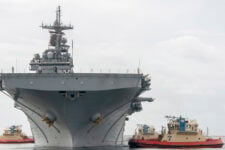
Navy Secretary Ray Mabus
WASHINGTON: In what looks very much like an opening shot in a fundamental fiscal battle between the four armed services and the Office of Secretary of Defense, Navy Secretary Ray Mabus came right out today and said we should preserve fighting forces by cutting Defense Department agencies that are “pure overhead,” His prime candidates? The testers who make sure the services’ weapons actually work; the Defense Logistics Agency that buys supplies like fuel; and — the particular target of the SecNav’s ire — the Defense Finance and Accounting Service.
Don’t cut my budget, cut the other fellow is a standard Washington plea in times of tightening budgets. Ray Mabus himself has repeatedly urged cost-cutters in Congress to spare the services and target the Defense Department’s independent agencies and the Office of the Secretary of Defense. But I’ve never heard him name names before. While the politically savvy SecNav stopped short of explicitly saying any particular agency should be cut, he was outspoken, even passionate, about which agencies were specific examples of the “pure overhead” he said should be cut in general.
“If you want to look at real money, 20 percent of the Pentagon budget — 20 percent, one dollar out of every five — is spent on the ‘fourth estate'[:] the Office of the Secretary of Defense, the defense agencies, the organizations run by the undersecretaries,” Mabus told the audience at the conservative American Enterprise Institute. “Pure overhead. Pure overhead. And they’ve grown far faster than the services.”
“There’s this thing called DFAS, Defense Finance and Accounting Service,” Mabus continued. “They write our checks. We tell them who to write the checks to, we tell them how to write them for, and they write the checks. Last year they charged us $300 million” for that service. (DFAS is a “working capital” agency funded largely by fees paid by other parts of the Defense Department).
That’s paying for something the Navy Department could do itself, Mabus implied. “We’ve got our own finance system, we’ve got our accounting system,” he said. “[But] we may not even have a shot at a clean audit because DFAS cannot tell us how they spent our money. Nine out of 10 of their internal controls have been found not to be effective. We cannot count on their data — that we gave ’em!”
So, I asked Mabus when moderator MacKenzie Eaglen opened the floor to questions, are you advocating the abolition of DFAS?
“Nice try, Sydney, on getting me into deep trouble,” Mabus replied. When the laughter died down, he said, “I think we should take a look at whether we need certain functions.”
“In theory, you ought to be able to do stuff DoD-wide and it should save [money], you should be able to consolidate stuff,” he continued. “In practice, it just doesn’t work very well.”
Consider another independent agency, he offered unsolicited. “The theory is that the Defense Logistics Agency can buy fuel cheaper if they buy it for everybody at once,” He said. “Well, the thing of it is we use different aircraft fuel than the Air Force because we operate in the maritime environment and they don’t. We use different fuel for our ships than anybody else. So it’s really not these big bulk fuel purchases, it’s service-specific fuel purchases” — just routed through another agency.
“The theory behind DLA is great,” Mabus said. “It’s unclear if it saves us anything.”
(DLA is another working capital fund agency, and part of the fee the services pay it goes to a kind of rainy-day fund to hedge against future spikes in oil prices, so a direct comparison of cost per barrel is tricky).
“If you do things DoD-wide, it usually goes to the lowest and slowest common denominator,” Mabus concluded, “whereas if you let the services compete, if you will, you tend to get things faster, you tend to get things done quicker.”
The Navy Secretary even had an unkind word for the Pentagon’s independent testing process. (He didn’t name names here, but the key player is the congressionally-mandated Director of Operational Test & Evaluation, DOT&E, which most on Capitol Hill consider a vital watchdog agency). “Testing proves that testing works,” Mabus said, but not necessarily much more. “We spend sometimes hundreds of millions on these tests and it’s unclear what the tests are telling us.”
DOT&E has been explicit in telling the Navy its controversial Littoral Combat Ship can’t stand up to enemy fire. But Mabus argued the testers refuse to account properly for LCS’s ability to avoid being hit in the first place and for the Navy’s plan to protect it with larger warships in any high-threat zone. To meet the tester’s standards for LCS survivability, he said, “you need a destroyer” — a ship more than four times the cost. If the Navy could afford to build destroyers for every mission, it wouldn’t have invented the Littoral Combat Ship in the first place.
In general, Mabus argued the services’ programs shouldn’t get second-guessed so much by the Office of the Secretary of Defense. On many programs, “senators and congressmen want to know why is this running over, why is this system not performing the way it should, and a lot of times we don’t have control of it,” Mabus said. “There’s no responsibility, there’s no accountability.”
The solution is to simplify the “spaghetti plate” structure of the defense acquisition system, with its redundant service and OSD processes, Mabus said. He’d also like to give the uniformed service chiefs a larger role, a controversial position shared by Army Chief of Staff Gen. Ray Odierno.
There’s a long backstory here. The Navy Department has been notoriously independent and resentful of Defense Department oversight ever since 1947. That’s why we had an infamous “revolt of the admirals” in 1949 but not a “revolt of the generals.” Many saw the very idea of merging the War Department and the Navy Department into a single agency as an Army bid for greater control. The turf wars continue today, in subtler ways. In recent years, for example, while most of my Army, Air Force, OSD, and defense agency contacts have moved to the Defense Information Systems Agency‘s centralized Enterprise Email, adopting new addresses ending in a standardized “@mail.mil,” the Navy and Marines stubbornly stick with “@navy.mil” and “@marines.mil.”
But rather than be parochially Navy, Mabus make clear he knows where his best potential allies lie. He made sure to appeal to the other armed services. When you’re under pressure to make big cuts, “the easy thing, the very, very easy thing [is to] take a BCT (Brigade Combat Team) from the Army, take an air wing from the Air Force, take a carrier strike group from the Navy when times get tough,” he said. “That affects the warfighter very directly. What we ought to be a lot better at is doing overhead, things that don’t affect the warfighter, things that don’t add value.”
Swedish DefMin: No plans to send personnel to Ukraine right now
Pål Jonson said if a “concrete proposal” was presented for allied countries to send personnel, Sweden would “take it into review.”


























